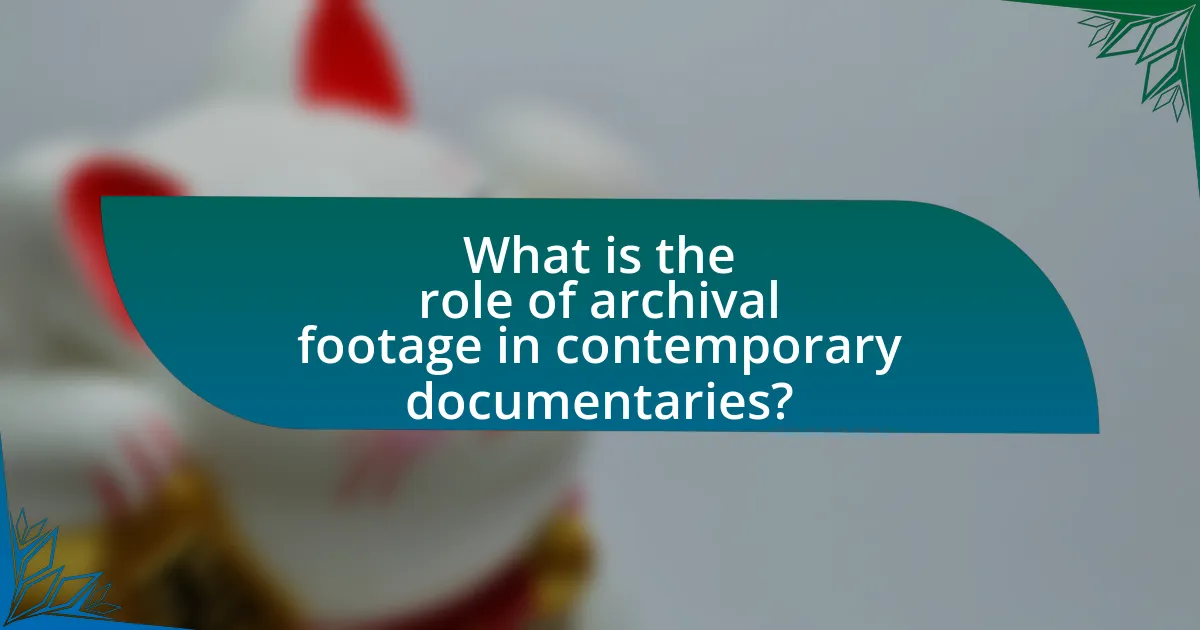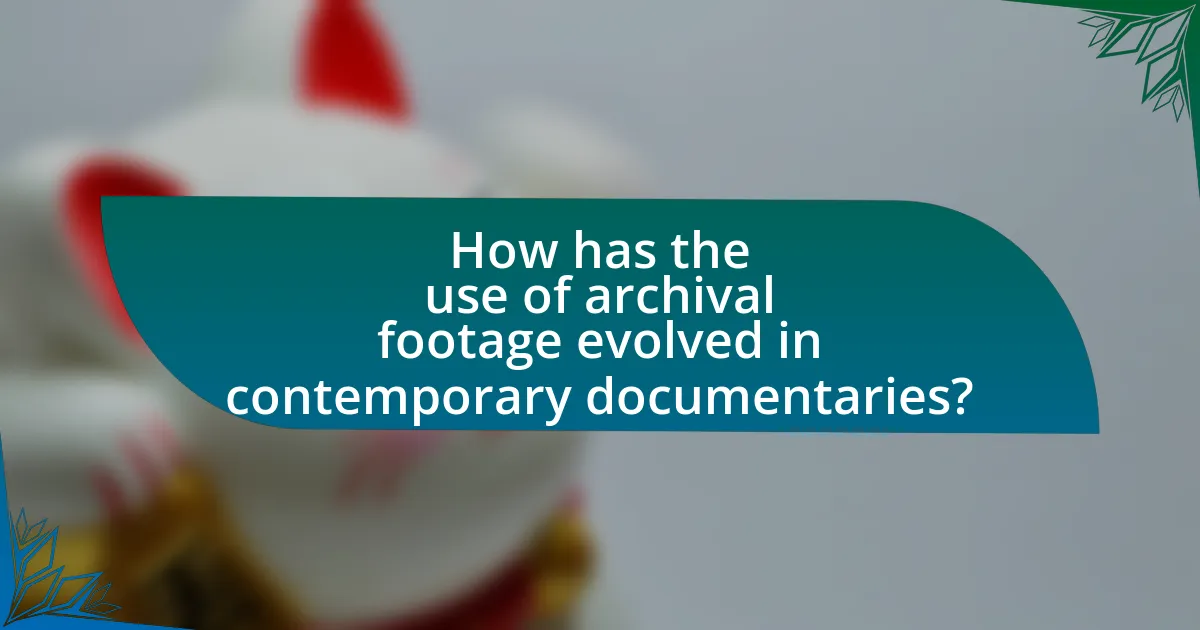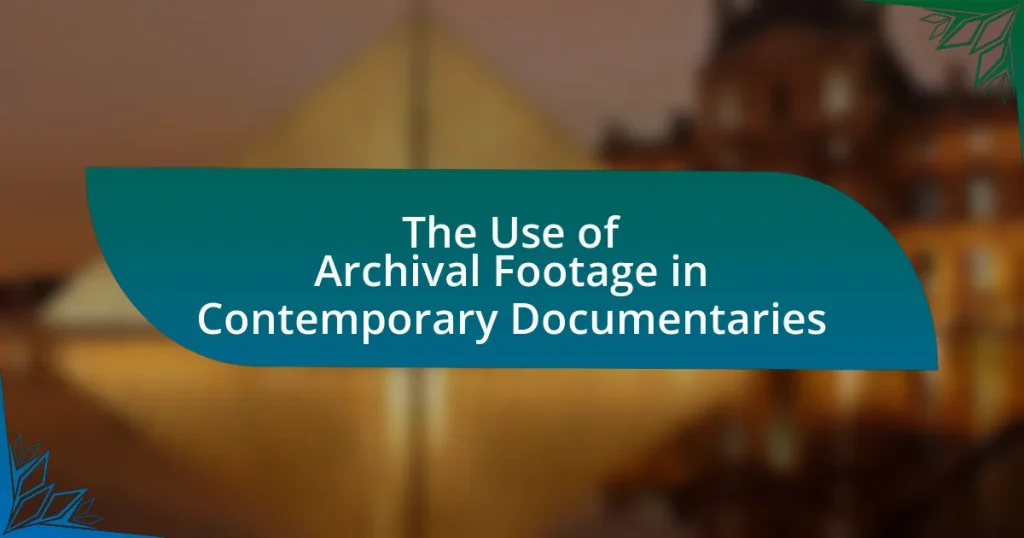The article examines the role of archival footage in contemporary documentaries, highlighting its importance in providing historical context, authenticity, and emotional impact. It defines archival footage as pre-existing film or video material used to support narratives and enhance storytelling, discussing various types such as historical clips, photographs, and audio recordings. The article also addresses the challenges filmmakers face when incorporating archival footage, including legal considerations and quality concerns, while emphasizing best practices for ethical sourcing and effective integration. Notable examples of documentaries that successfully utilize archival footage are presented, showcasing techniques that enhance narrative depth and viewer engagement.

What is the role of archival footage in contemporary documentaries?
Archival footage serves as a critical element in contemporary documentaries by providing historical context and authenticity to the narrative. This type of footage allows filmmakers to illustrate past events, evoke emotions, and enhance storytelling by visually connecting viewers to the subject matter. For instance, documentaries like “13th” by Ava DuVernay utilize archival footage to highlight systemic racism in the United States, effectively grounding the film’s arguments in real historical events. The inclusion of such footage not only enriches the documentary’s content but also engages audiences by offering a tangible link to the past, thereby reinforcing the documentary’s credibility and impact.
How is archival footage defined in the context of documentaries?
Archival footage in the context of documentaries is defined as pre-existing film or video material that is used to provide historical context, support narratives, or enhance storytelling. This type of footage often includes news clips, home movies, or previously recorded interviews that are relevant to the documentary’s subject matter. For instance, the documentary “The Act of Killing” utilizes archival footage to juxtapose historical events with contemporary interviews, thereby enriching the viewer’s understanding of the narrative.
What types of archival footage are commonly used in documentaries?
Common types of archival footage used in documentaries include historical film clips, photographs, audio recordings, newsreels, and personal home videos. Historical film clips provide visual context for events, while photographs can capture moments that are significant to the narrative. Audio recordings, such as interviews or speeches, add depth to the storytelling. Newsreels offer contemporary perspectives on past events, and personal home videos can provide intimate insights into individual experiences. These types of archival footage enhance the documentary’s authenticity and help convey the intended message effectively.
How does archival footage differ from other documentary footage?
Archival footage differs from other documentary footage primarily in its origin and purpose; archival footage consists of pre-existing material that was recorded in the past, often for different purposes, while other documentary footage is typically shot specifically for the documentary at hand. Archival footage is used to provide historical context, authenticity, or visual evidence of events that have already occurred, such as news clips, home videos, or government records. In contrast, other documentary footage is created to capture current events, interviews, or reenactments, tailored to the narrative and themes of the specific documentary. This distinction is crucial as it influences the storytelling approach, the authenticity perceived by the audience, and the overall production style of the documentary.
Why is archival footage important for storytelling in documentaries?
Archival footage is crucial for storytelling in documentaries because it provides authentic visual evidence that enhances the narrative’s credibility and emotional impact. This type of footage allows filmmakers to present historical events, cultural contexts, and personal stories with a level of authenticity that contemporary recreations cannot achieve. For instance, documentaries like “The Act of Killing” utilize archival footage to juxtapose past atrocities with present-day reflections, thereby deepening the viewer’s understanding of the subject matter. Furthermore, research indicates that viewers are more likely to engage with and retain information from documentaries that incorporate archival materials, as these visuals create a stronger connection to the real events being depicted.
What emotional impact does archival footage have on viewers?
Archival footage evokes strong emotional responses in viewers by providing authentic visual connections to historical events. This authenticity can elicit feelings of nostalgia, empathy, and even trauma, as it allows audiences to witness real moments that shaped history. For instance, studies have shown that viewers often experience heightened emotional engagement when they see actual footage from significant events, such as wars or social movements, compared to reenactments or dramatizations. The emotional impact is further amplified by the context in which the footage is presented, as it often serves to humanize historical narratives and create a deeper understanding of the past.
How does archival footage enhance historical accuracy in documentaries?
Archival footage enhances historical accuracy in documentaries by providing authentic visual evidence of past events. This footage serves as a primary source, allowing filmmakers to present real-life moments that occurred during the time being depicted, thereby grounding the narrative in factual occurrences. For instance, documentaries about World War II often utilize archival footage of battles, speeches, and civilian life, which not only illustrates the historical context but also evokes emotional responses from viewers. The use of such footage can be corroborated by historical records, ensuring that the representation aligns with documented events, thus reinforcing the credibility of the documentary.
What challenges do filmmakers face when using archival footage?
Filmmakers face several challenges when using archival footage, primarily related to copyright issues, quality concerns, and contextual relevance. Copyright issues arise because many archival materials are protected, requiring filmmakers to obtain licenses or permissions, which can be time-consuming and costly. Quality concerns include the degradation of older footage, which may not meet modern technical standards, necessitating restoration efforts that can be resource-intensive. Additionally, filmmakers must ensure that the archival footage is contextually relevant to their narrative, as misrepresentation can lead to historical inaccuracies and undermine the documentary’s credibility. These challenges highlight the complexities involved in integrating archival footage effectively into contemporary documentaries.
What legal considerations must be addressed when incorporating archival footage?
When incorporating archival footage, legal considerations include copyright, licensing, and rights of publicity. Copyright laws protect the original creators of the footage, requiring permission or licensing agreements to use their work. Additionally, rights of publicity laws protect individuals’ images and likenesses, necessitating consent from identifiable persons in the footage. Failure to address these legal aspects can lead to infringement claims and potential litigation, as established by cases like Campbell v. Acuff-Rose Music, Inc., which underscored the importance of obtaining rights for derivative works.
How do filmmakers ensure the quality and relevance of archival footage?
Filmmakers ensure the quality and relevance of archival footage by conducting thorough research and verification processes. They assess the authenticity of the footage by cross-referencing it with credible sources, such as historical records or expert testimonies. Additionally, filmmakers often evaluate the technical quality of the footage, including resolution and clarity, to ensure it meets contemporary standards. For instance, the National Archives and Records Administration provides guidelines for evaluating archival materials, which filmmakers can utilize to maintain high standards. This meticulous approach helps filmmakers select footage that not only enhances the narrative but also resonates with the audience’s understanding of the subject matter.

How has the use of archival footage evolved in contemporary documentaries?
The use of archival footage in contemporary documentaries has evolved to become more integrated and essential for storytelling. Filmmakers now utilize archival material not just for historical context but also to create emotional resonance and enhance narrative depth. For instance, documentaries like “13th” by Ava DuVernay effectively combine archival footage with contemporary interviews and graphics to address systemic racism, illustrating how past events shape current societal issues. This evolution reflects a broader trend where archival footage is curated and manipulated to serve specific thematic purposes, allowing for a more dynamic engagement with the audience.
What technological advancements have influenced the use of archival footage?
Technological advancements such as digital editing software, high-definition video formats, and cloud storage have significantly influenced the use of archival footage. Digital editing software, like Adobe Premiere Pro and Final Cut Pro, allows filmmakers to seamlessly integrate archival material into new narratives, enhancing storytelling. High-definition video formats have improved the quality of archival footage, making it more visually appealing and suitable for modern audiences. Additionally, cloud storage solutions enable easy access and sharing of large archival collections, facilitating research and collaboration among filmmakers. These advancements collectively enhance the accessibility, quality, and integration of archival footage in contemporary documentaries.
How has digital editing changed the way archival footage is utilized?
Digital editing has significantly transformed the utilization of archival footage by enabling more seamless integration and enhanced storytelling capabilities. This technology allows filmmakers to manipulate and combine various clips with precision, creating a cohesive narrative that resonates with contemporary audiences. For instance, digital editing software facilitates the restoration of old footage, improving visual quality and making it more accessible for modern viewers. Additionally, the ability to overlay graphics, sound, and new footage enhances the context and emotional impact of archival material, as seen in documentaries like “13th” by Ava DuVernay, which effectively uses archival footage to support its themes of systemic racism. This evolution in editing techniques has made archival footage a vital component in contemporary documentary filmmaking, enriching the storytelling experience.
What role does online accessibility play in the use of archival footage?
Online accessibility significantly enhances the use of archival footage by allowing broader public access to historical materials. This increased access enables filmmakers, researchers, and educators to incorporate diverse archival content into contemporary documentaries, enriching narratives and providing historical context. For instance, platforms like the Internet Archive and various digital archives have made millions of historical videos available, facilitating the integration of archival footage into new works. This democratization of information not only fosters creativity but also promotes a more informed public discourse by making historical resources readily available for analysis and interpretation.
How do contemporary filmmakers select archival footage for their projects?
Contemporary filmmakers select archival footage for their projects by assessing its relevance, authenticity, and emotional impact. They prioritize footage that aligns with the narrative and themes of their documentary, ensuring it enhances storytelling. Filmmakers often conduct thorough research to verify the historical accuracy and context of the footage, utilizing databases, archives, and libraries to source material. For instance, the Library of Congress and the British Film Institute provide extensive collections that filmmakers can access. Additionally, filmmakers consider the quality and resolution of the footage to ensure it meets modern production standards, as seen in projects like “13th” by Ava DuVernay, which effectively integrates archival footage to support its arguments on systemic racism.
What criteria do filmmakers use to determine the appropriateness of archival footage?
Filmmakers determine the appropriateness of archival footage based on relevance, authenticity, and legal considerations. Relevance ensures that the footage directly supports the narrative or themes of the documentary, enhancing the viewer’s understanding. Authenticity involves verifying the source and context of the footage to maintain credibility and accuracy, as seen in documentaries like “The Act of Killing,” where filmmakers used authentic archival materials to depict historical events. Legal considerations include copyright and licensing issues, ensuring that the footage can be legally used without infringing on rights, which is crucial for avoiding legal disputes.
How do filmmakers balance archival footage with original content?
Filmmakers balance archival footage with original content by strategically integrating historical material to enhance narrative depth while ensuring the original content provides context and continuity. This approach allows filmmakers to create a cohesive story that resonates with audiences, as seen in documentaries like “13th,” where archival footage of historical events is juxtaposed with contemporary interviews and analysis, effectively illustrating the ongoing impact of systemic racism. By carefully selecting archival clips that complement original interviews and commentary, filmmakers maintain a dynamic flow that engages viewers and supports the documentary’s thesis.
What are some notable examples of contemporary documentaries that effectively use archival footage?
Notable examples of contemporary documentaries that effectively use archival footage include “13th,” directed by Ava DuVernay, which utilizes historical footage to explore the intersection of race, justice, and mass incarceration in the United States. Another example is “Won’t You Be My Neighbor?” directed by Morgan Neville, which incorporates archival clips from Fred Rogers’ television show to illustrate his impact on children’s television and emotional education. Additionally, “The Act of Killing,” directed by Joshua Oppenheimer, employs archival footage to confront the Indonesian genocide, allowing perpetrators to reenact their experiences. These documentaries demonstrate the powerful role archival footage plays in enhancing narrative depth and historical context.
What techniques did these documentaries employ to integrate archival footage?
Documentaries employ techniques such as juxtaposition, narration, and thematic framing to integrate archival footage effectively. Juxtaposition allows filmmakers to contrast historical footage with contemporary visuals, enhancing the narrative’s emotional impact. Narration often provides context, guiding viewers through the archival material and linking it to current events or themes. Thematic framing organizes the archival footage around specific topics, ensuring that it serves a clear purpose within the documentary’s overall message. These techniques are validated by their frequent use in acclaimed documentaries, which demonstrate how archival footage can enrich storytelling and provide deeper insights into historical contexts.
What impact did the archival footage have on the overall narrative of these documentaries?
Archival footage significantly enhances the overall narrative of contemporary documentaries by providing authentic visual context and historical credibility. This footage allows filmmakers to present real events and figures, thereby grounding the narrative in factual history, which can evoke emotional responses from the audience. For instance, documentaries like “13th” utilize archival footage of civil rights protests, which not only illustrates the historical struggle but also connects past injustices to current societal issues, reinforcing the film’s argument about systemic racism. Such integration of archival material enriches storytelling by creating a more immersive and impactful viewing experience.

What best practices should filmmakers follow when using archival footage?
Filmmakers should ensure they have the legal rights to use archival footage, as unauthorized use can lead to copyright infringement. Securing licenses or permissions from copyright holders is essential to avoid legal issues. Additionally, filmmakers should provide proper context for the archival footage, including sourcing and historical accuracy, to enhance the narrative and maintain credibility. This practice is supported by the fact that documentaries relying on accurate representation of events are more likely to be well-received by audiences and critics alike. Furthermore, filmmakers should consider the quality of the footage, as high-resolution and well-preserved materials contribute to a more professional final product. Research indicates that documentaries utilizing high-quality archival footage tend to engage viewers more effectively, as seen in successful films like “13th” by Ava DuVernay, which employed carefully curated archival materials to support its themes.
How can filmmakers ethically source archival footage?
Filmmakers can ethically source archival footage by obtaining proper permissions and licenses from copyright holders. This involves identifying the original creators or rights holders of the footage and negotiating terms for its use, ensuring compliance with copyright laws. For instance, the U.S. Copyright Act protects original works, and filmmakers must respect these rights to avoid legal repercussions. Additionally, filmmakers should consider the context in which the footage was created and ensure that its use aligns with ethical standards, such as not misrepresenting the original intent or message. By following these practices, filmmakers can responsibly incorporate archival footage into their projects while honoring the rights of the original creators.
What steps should be taken to obtain permissions for archival footage use?
To obtain permissions for archival footage use, one must first identify the copyright holder of the footage. This involves researching the source of the footage, which may include production companies, archives, or individual creators. Once the copyright holder is identified, the next step is to contact them directly to request permission, providing details about how the footage will be used, the context of the project, and any distribution plans. It is essential to negotiate terms, including potential fees or licensing agreements, and to obtain the permission in writing to ensure legal protection. Following these steps ensures compliance with copyright laws and secures the necessary rights for usage.
How can filmmakers ensure proper attribution for archival footage?
Filmmakers can ensure proper attribution for archival footage by obtaining explicit permission from the copyright holder and providing clear credit in the film’s credits. This process involves identifying the source of the archival material, whether it is a public archive, a private collection, or an individual creator, and adhering to any specific attribution requirements set by the copyright holder. For instance, the U.S. Copyright Office emphasizes the importance of securing rights and providing proper attribution to avoid legal issues and respect the original creators’ contributions.
What tips can enhance the effectiveness of archival footage in documentaries?
To enhance the effectiveness of archival footage in documentaries, filmmakers should ensure that the footage is contextually relevant and seamlessly integrated into the narrative. Contextual relevance allows the archival material to support the documentary’s themes and messages, while seamless integration maintains viewer engagement. For instance, using archival footage that directly relates to the subject matter can evoke emotional responses and provide historical authenticity, as seen in documentaries like “13th,” which effectively uses archival clips to illustrate systemic racism in America. Additionally, employing techniques such as voiceover narration or on-screen text can clarify the significance of the footage, making it more impactful for the audience.
How can filmmakers create a cohesive narrative using archival footage?
Filmmakers can create a cohesive narrative using archival footage by carefully selecting and integrating relevant clips that align with the story’s themes and objectives. This process involves curating footage that not only supports the narrative arc but also provides historical context, emotional resonance, and authenticity. For instance, the documentary “13th” by Ava DuVernay effectively uses archival footage to illustrate systemic racism in the United States, weaving together historical events with contemporary issues to create a powerful narrative. By establishing clear connections between the archival material and the present-day storyline, filmmakers can enhance viewer understanding and engagement, ultimately leading to a more impactful documentary.
What editing techniques can maximize the impact of archival footage?
To maximize the impact of archival footage, editors can employ techniques such as juxtaposition, pacing, and sound design. Juxtaposition involves placing archival footage alongside contemporary interviews or visuals to create a contrast that highlights changes over time, enhancing emotional resonance. Pacing is crucial; varying the speed of footage can build tension or provide relief, guiding the audience’s emotional journey. Sound design, including the use of voiceovers, ambient sounds, or music, can amplify the emotional weight of the visuals, making the archival content more engaging and impactful. These techniques are supported by studies in documentary filmmaking that emphasize the importance of emotional engagement in audience retention and understanding.


